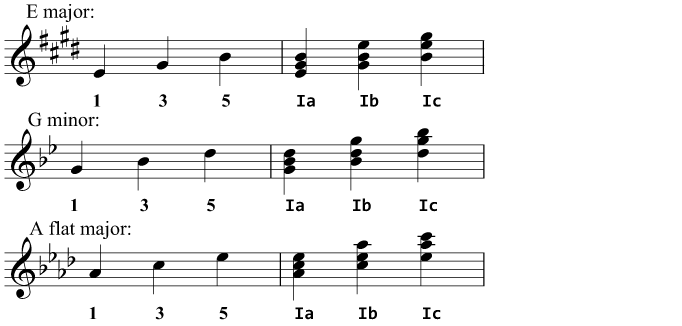Functions of harmony
In this guide...
Key terms:
Subscription required!
To view the complete study guide, you will need a valid subscription. Why not subscribe now?
Already have a subscription? Make sure you login first!
Introduction
Now we know all about triads and inversions, it's time to discover more before we can get on to the fun part: joining them up to make music!
Triads
First of all let's have a brief reminder about triads, the building block of harmony. Recall that we form a tonic triad, also known as a triad on I, by taking the 1st, 3rd, and 5th degrees of the scale and stacking them together.
The 1st degree is called the root of the triad, and when the triad is in root position, the root is in the bass.
We then learned how the other two notes (the 3rd and 5th degrees) can be in the bass, and that these different forms of the same triad are called the first inversion (3rd in the bass) and the second inversion (5th in the bass).
 Some tonic triads in various keys, in all inversions
Some tonic triads in various keys, in all inversionsRecall also that we label these triads and inversions with Roman numerals; the tonic triad in a major key in root position is called Ia with Ib and Ic the inversions; in a minor key these are called ia, ib, and ic because the tonic triad is a minor triad.
Why is the tonic triad in a minor key a minor triad?
That's because the interval between root and the 3rd is a minor 3rd. In a major key, the interval between root and 3rd is a major 3rd, and so the tonic triad in a major key is a major triad.
Triads on other degrees
Triads are not just created on the 1st degree: we can build triads on any note of the scale using the same principles.
For instance, in C major, we can build a triad on G using G as the root note, B as the third (one third above G) and D as the fifth (a fifth above G). This triad would be called V or the dominant triad (after the dominant - the 5th degree of the scale).
Similarly, also in C major, we can build a triad on F using F as the root, A as the third, and C as the fifth. This triad, on the 4th degree of the scale, is called IV or the subdominant triad.
The following example shows how these triads are constructed:
 Constructing triads of
Constructing triads of IV and V in C majorThe inversions of these new triads work in just the same way as for I: the third at the bottom gives the first inversion, and the fifth at the bottom gives the second inversion:
 The inversions of
The inversions of I, IV and V in C majorIt is important to note that when we talk about the "third of IV", for example, we are no longer talking about the 3rd degree of the scale, but we are talking about the note a third above the root of the chord.
In C major, the third of the triad IV is the note A, which is the 6th degree of C major. Similarly, the fifth of the triad V in C major is the note D, which is the 2nd degree of the scale.
Primary triads
The triads I, IV and V (and the chords created with them) are especially important and are sometimes referred to as the primary triads.
A great deal of music is based on just these three chords alone!
Of the primary triads, the most important are the tonic (I) and dominant (V) triads. These two usually provide most of the harmonic "pull" within a piece of music, and give music a sense of purpose and direction.
The perfect cadence
A cadence is a chord progression - a sequence of successive chords - which occurs at the end of a passage of music. A cadence, precisely, is the last two chords in a chord progression.
The most important type of cadence used to end a piece of music is called the perfect cadence and is formed of the chord V followed by chord I.
The perfect cadence at the end of a musical phrase is a bit like the full stop at the end of the sentence, it marks completion and has a strong sense of "The End".
 A perfect cadence in C major:
A perfect cadence in C major: V followed by IMelodic cadences
The example above is written in four-part harmony, and this is a common way to write down cadences for illustration and clarity. It is not the only way, however, and just as harmony doesn't necessarily happen all at once (a chord can be "broken" for example), so a cadence doesn't necessarily consist of two block chords.
Here is a short example showing how cadences can be found even in purely melodic music. Try playing both of these examples and listen out for the cadence: it should be equally recognisable in the melodic example as in the four-part example!
 A perfect cadence in a melody, also in C major
A perfect cadence in a melody, also in C majorWe sometimes simply call the perfect cadence a V-I cadence, and both are equally valid terms, but you will need to be able to recognise both.
Functions
It is possible to describe any two chords that end a phrase as a cadence, and there are several different types other than the perfect cadence that we will meet soon. However, none of these other types of cadence have the same sense of finality as the perfect cadence, and they generally invite the music to continue into the next phrase.
This gives some sense of the importance of V and I.
V and I have particularly strong roles or functions in music. The tonic chord (I) functions as the "home" chord. We start with it, we return to it, and we end with it.
During the course of the music, we go to other places "away from home" for the sake of variety, and the most common place to go to is the dominant.
You can therefore almost consider the dominant to be the "opposite" of the tonic, in the way that North and South are opposite, or Left and Right, or Up and Down: the tonic makes little sense without the dominant, and North, Left, and Up would make little sense without South, Right, and Down.
Here's an eye-catching way to think of tonic and dominant:
 One way to think of the relationship between tonic and dominant!
One way to think of the relationship between tonic and dominant!Triads in minor keys
Minor keys are much more tricky because of the different scale forms, and the accidentals introduced by these different scales.
When we create triads in a minor key, we always use the harmonic minor scale. This is the purpose of the harmonic minor scale - harmony!
This has one important consequence which so frequently causes problems that we'll put it in a red box:
The dominant in minor keys
Due to the raised 7th degree of the harmonic minor scale, the third of the dominant triad will always, too, be raised.
The consequence of this is that dominant triad in a minor key is always a major triad, and not the minor triad that you would expect from the unaltered notes of the key signature.
This is demonstrated here in C minor:
 Constructing the triad of
Constructing the triad of V in C minor, with the accidentalThere is no problem with the subdominant triad, which simply uses the unaltered notes of the key signature, as none of the notes in this triad are altered in the harmonic minor scale. It is, however, a minor triad just like the tonic triad in a minor key:
 Constructing the triad of
Constructing the triad of iv in C minorAs with the minor tonic triad, the minor subdominant triad also uses the lower case when in Roman numeral notation: iv , with iva, ivb, ivc for the inversions.
But, as you've learned from the red box above, the dominant triad is always a major triad and so you'll only ever see V and never v!
Chord progressions
As explained above, the cadence is the term used for the closing chords of a chord progression.
However, chords underlie the music all the way through, and progressions are what drive it forwards. The selection of the chords for the progression are important in giving the music a sense of direction and movement.
The chord (i.e., the triad) selected to accompany a given note normally contains those notes; so for example in C major it would be unusual to harmonise the note B with the tonic triad (which contains C, E, and G). It would be better to select the dominant triad, containing G, B, and D.
The example below is a simple harmonisation of a hymn tune in four-part harmony. As you can see, it uses chords based on only the primary triads:
 A harmonisation with a chord progression using chords based on only the primary triads
A harmonisation with a chord progression using chords based on only the primary triadsNotice that between the primary triads, we have all the notes of the scale. That perhaps explains why so much music uses only I, IV, and V.
As you advance in your study of harmony, you will discover that other triads which can be created on other degrees of the scale (II, III, and so on) are often used as substitutes for the primary triads, which make the harmonisation and the chord progression much more interesting.
Read more...
With a subscription to Clements Theory you'll be able to read this and dozens of other study guides, along with thousands of practice questions and more! Why not subscribe now?
Revision
Are you sure you've understood everything in this study guide? Why not try the following practice questions, just to be sure!